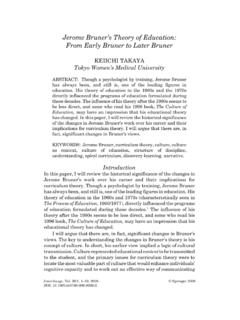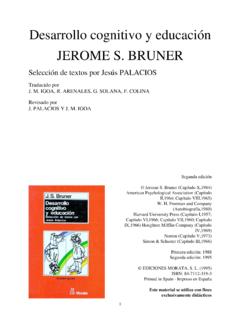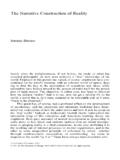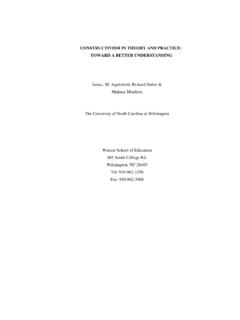Transcription of Solutions: Dilutions. A. Dilutions: Introduction - b Bruner
1 solutions : Dilutions: The dilution The logic of the dilution Should you memorize the dilution equation? -- Attention X11 Practical Dilutions involving other concentration dilution Multiple dilutions; serial handout was originally written for another purpose. It was intended as aself-paced review for students to use on their own, with staff available for was part of a set of several such handouts. Some of the other handouts arementioned here; if you are interested in one of them, let me handout follows Molarity. One problem uses material from Percentage. However, for themost part, Dilutions and Percentage are independent; they can be done in parallel, or in Dilutions: IntroductionIn the previous work we discussed preparing solutions from the pure components (for example,solid NaCl solute and the solvent, water). However, sometimes you prepare one solution fromanother.
2 In particular, it is common to take a concentrated solution and prepare a dilutesolution, by adding more solvent. (The terms concentrated and dilute are qualitative terms thatrefer to a -- relatively -- high or low concentration, respectively, of solute in the solution.)Preparing solutions by dilution is convenient. One can make a single concentrated stocksolution of a solute, and then quickly prepare a variety of more dilute solutions by dilution .(Why is it easier? Measuring volumes is quicker than weighing.) Further, dilution of aconcentrated solution is a practical way to make solutions that are so dilute you would havetrouble weighing the is a simple equation for calculating dilutions. It is also easy to present the logic of mainly discuss dilution problems using molarity as the concentration the problem sets, some problems are marked with an *. This indicatesthat the problem introduces something new.
3 If you are skipping around in theproblems, you may well want to stop for a bit at a problem marked with an *. solutions : 2I did not intend significant figures (SF) to be an issue when I wrote the originalversion of this. However, some who use this now may care about SF. Theanswers do now show the correct number of SF. Exception: In some simpleproblems, with simple integer data, I have treated the data as exact .B. The dilution equationVcMc = this equation, V = volume and M = molarity. The subscripts c and d refer to the concentratedand dilute solutions , : 100 mL of M NaCl. Have: a M NaCl stock make the desired solution, we will take some volume (Vc) of the concentrated solution, andthen add water (solvent) until the total volume is the desired 100 mL. The question is, howmuch of the concentrated solution do we need, or what is Vc?Given: Vd = 100 mL (= L); Md = M; Mc = M.
4 If you can identify these three givens,then you can simply use the dilution equation to calculate Vc. So as you do this example -- andreal problems -- emphasize identifying the givens. In common dilution problems, you know thedesired volume and concentration of the new, dilute solution (Vd and Md), and you know theconcentration of the stock solution (Mc); the goal is to find out how much of the stock you need(Vc).VcMc = VdMd VdMd L x MVc = = = L ( = 20 mL) Mc MThus, Vc = 20 mL. To make the desired solution, take 20 mL of the M stock solution, thenadd enough water to make 100 mL total volume of solution. (As discussed before, thedenominator of molarity is volume of solution; the final volume is determined by measuring thesolution, not the amount of solvent added.)Note about the unit M. In this problem we wrote M in the problem, and we canceled M s.
5 Thatmay seem to contradict previous advice that you should (usually) expand M in problems, tomol/L. No harm would be done by expanding M here, but that isn t needed. How do you know?Look at the units in the problem. In this case, we do not need to deal with the mol or Lseparately; the M s simply cancel. (Previous M problems dealt with converting moles L.) solutions : 3 Note about Vc, and a hidden assumption. Vd is simple enough; it is the amount of the dilutesolution you are making. It may be tempting to think that Vc is the amount of the concentratedsolution you have. WRONG. It is the amount you use. So how much do you have? Don t know,except that it is plenty (an excess ). You must have enough of the concentrated to do whatyou want, but the amount you have per se is not an issue. You calculate how much you need,and take that from the stock. (If there isn t enough stock, someone needs to make more; seeMolarity.)
6 Pitfall; important check. The most common mistake in doing dilution calculations is to use theequation backwards, to get c and d at least partially mixed up. The first protection against thisproblem is to be careful with the units. Look at the example above. The M units cancel, and theonly remaining unit is the volume unit -- in the numerator. Thus the set-up gives volume, whichis what we want. If your set-up doesn t give volume, or gives volume in the denominator, it iswrong. Watch the units. (Remember, the point of using dimensional analysis is to guide youtoward correct set-ups and away from incorrect ones. Just writing the unit you know you want,even if it doesn t come out of the set-up, seriously misses the value of using dimensionalanalysis.)Unfortunately, dimensional analysis alone won t protect you from the second part of the pitfall -- but common sense will. What if you mix up the two concentrations, putting the wrong one ontop?
7 You will still get volume, but you will get the wrong volume -- an obviously unreasonablevolume. In the example, if you reverse the two concentration terms, you will get Vd = 500 answer says to take 500 mL of stock solution, and add water until you get to 100 ! Obviously nonsense!The overall watch the units and check that the result seems reasonable. Theseprecautions are good general precautions in all you can t exactly recall the dilution equation, the precautions may be enough to guide you todo the calculation correctly. The desired volume must be the given volume times the ratio ofconcentrations; that will give you volume. And the ratio of concentrations must be written sothat the answer comes out as The logic of the dilution equation[You do not need to understand the basis of the dilution equation in order toproperly use it. However, the equation is rather easy to understand, andunderstanding it can help develop your intuition about how to approachproblems.]
8 Further, if you do dilution calculations only occasionally, it mayactually be easier and safer to solve them from first principles than to try toremember the dilution equation and to use it properly.]Think moles. Once again, the mole underlies chemical know thatSolutions: 4 molesmoles = volume * molarity = volume * volume(where volume means volume of solution).Recall the Example in Sect B, above. The desired solution is 100 mL (Vd) of M NaCl (Md).Using the above relationship, we need VdMd = L * ( mole/L) = mole of we were making the solution from solid solute, we would convert the amount needed ( ) to mass, using the molar mass. (See the Molarity handout.)But in this case we don t need to weigh out the NaCl. We already have some NaCl in solution,in a M (Mc) solution. How can we get the mole we need from a solution that M = mole/L?
9 Well, that mole must also = VcMc. Rearranging the relationship, Vc =moles/Mc = mole/( mole/L) = L. (Write that out clearly, so you can see that theunits work.)This result, L = 20 mL, is what we calculated earlier from the dilution equation. Thatequation combines the two steps: how many moles of solute do we need; what volume of stockdoes it take to get that many Should you memorize the dilution equation? -- Attention X11 studentsIn this worksheet, I started by presenting the dilution equation, in Sect B. I then described thelogic of that equation, in Sect C. In Sect B, I cautioned about making sure you are clear whatthe terms means, especially the subscripts c and d. And at the start of Sect C, I cautioned that ifyou do dilutions only occasionally, you might actually be better off to not use the worksheet was originally written for a review class, in which most of the students weretrying to become more comfortable with chemical calculations.
10 Learning to use the dilutionequation, which presumably they had learned about previously, seems reasonable in , some students are now using this worksheet as a supplement for an introductorychemistry class, and focusing on the dilution equation may not be the best approach. In fact, Iminimize discussion of the dilution equation in the introductory course. Dilutions can be easilyand logically done from first principles , as discussed in Sect C:1. How many moles of solute do you need?2. Where do you get those moles from (in this case, what volume of the concentratedsolution)?It is so easy to solve dilution problems that way that I really encourage it for beginning who use dilutions a lot will undoubtedly want to remember how to use the dilutionequation, since it is a little bit quicker. But it is not much quicker, and for occasional use reallymay not be worth the risk of using it : 5It is ok for students in my introductory classes to use the dilution equation, but I give no partialcredit for using it incorrectly.








